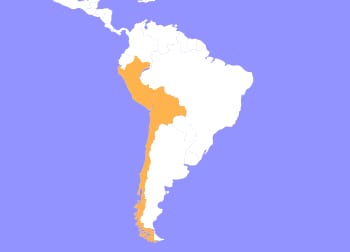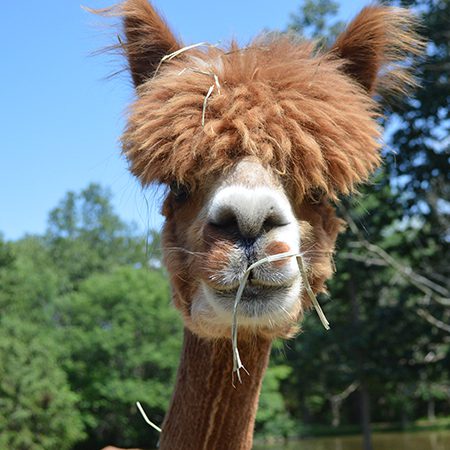Alpaca
Vicugna pacos
Alpacas are the smallest of the domesticated camelidae species, not to be confused with their relatives, the llama. Average height for alpacas is 3 feet at the shoulder and they can weigh between 121 to 143 lbs. By comparison, llamas stand almost 4 feet at the shoulder and can weigh 286 to 341 pounds. Alpacas are native to South America, in the southern Andes at elevations above 4500 meters. In the 1980s alpacas started being exported to other countries for farming purposes, including the United States, New Zealand, Australia, and the Netherlands.
Since they’ve been transported, they have become prized pets, considered to be adorable, docile, and soft. According to “The Alpaca Owners and Breeders Association” alpaca coats have up to 22 colors, from black through brown and tans to white. These guys are pack animals and do best and thrive living in numbers. Alpacas are known for their two distinct breeds of Suri and Huacaya. While Huacayas make up 95% of all domesticated alpacas, Suris are rarer with only about 5,000 registered in the United States. Huacayas Alpaca hair grows in a “crimpy” perpendicular direction to the skin, giving them a wooly appearance. Suris have straight fiber hair that curls towards the ground hanging low looking almost like dreadlocks.
Say Hello To Cub Creek's Alpacas: Angel, Amelia and Brock
Angel is the father to our younger Alpacas. This stud is all black with a white chin and chest. Angel really is an angel as he likes to kiss people..on the lips! Brock was born in the summer of 2013 to Layla and Angel. He is distinguished by his white chin (Just like his dad Angel)! Amelia is camp’s youngest Alpaca born in the Summer of 2014 to Layla and Angel.

Alpacas are native to the heights of the Andes in Southern Peru, Western Bolivia, Ecuador, and Northern Chile.
HABITAT -Alpacas native habitat is the heights of the Andes mountains in South America.
DIET -Alpacas are grazing animals that eat lush green grasses. Domesticated Alpacas will also eat hay.
FUN FACT -You’ll sometimes find alpacas rolling around on the ground because they love dust baths!
SOCIAL BEHAVIOR -They are social animals that thrive in herds. Very sociable with humans..
ACTIVITY -Alpacas are diurnal, meaning they are active during the day and sleep at night.
PREDATORS -Alpacas are diurnal, meaning they are active during the day and sleep at night.
SIZE -Alpacas can range between 100 - 200 lbs, with an average height anywhere between 2 - 3 feet.
RELATIVES -Alpacas are a camelidae species which is related to camels and llamas.
CONSERVATION -Alpacas are categorized as NE (Not Evaluated) species by the IUCN.
Cub Creek Animal Care Information
Housing - Our alpacas inhabit the pasture known as Llama Land here at camp. This large open pasture includes lush green grasses for grazing, access to an open pond for fresh water, and dryer terrain for dust baths. This pasture has stalls built in to provide shelter and cover from predators and extreme weather, the stalls are bedded with hay to provide warmth and a soft bedding. Pastures are regularly mucked to ensure the habitat is clean.
Diet - We feed our Alpacas a mixture of Allstock / livestock feed grain and hay, which is supplemented by the lush green grasses they graze upon. They can also enjoy special treats like apples, chopped carrots, celery, lettuce, parsley, and cabbage. It must be given sparingly so that their systems can get used to them over time.
Enrichment - Hanging hay feeders are used as enrichment, which have different sized openings for the Alpaca to eat hay from. Scatter feeding has also been done to help make mealtimes last longer, and allows them to eat slower. Since the food is more spread out rather than in one large pile, they must do a bit more foraging. During the summer time, campers love to come hang out with the alpacas and give them plenty of socialization and enrichment. Campers have been known to make sweet fruit treat popsicles for our alpacas.


